Ultimate Guide to Buying The Best Christmas Tree
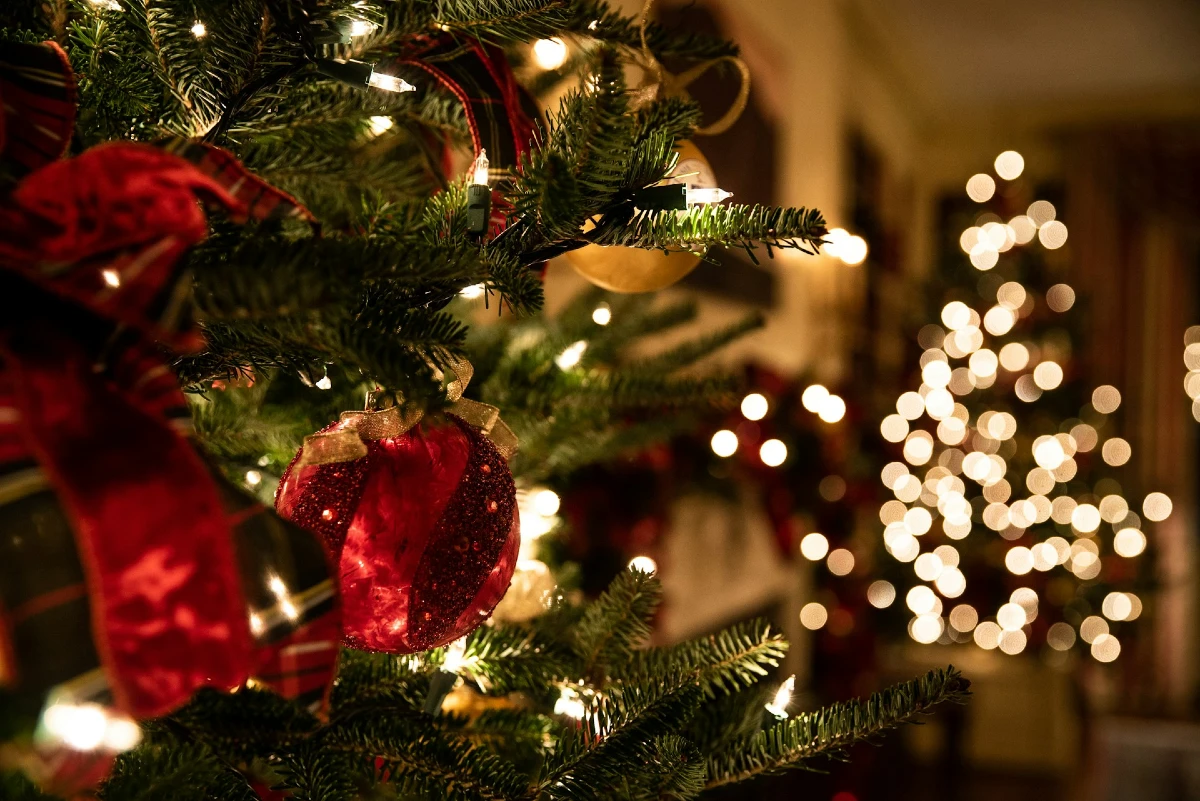
Spending a hundred bucks on a Christmas tree that looks dead by December 20th? Hard pass. The truth is, your tree sets the tone for the whole holiday — it’s the centerpiece, the photo backdrop, the thing you’ll smell every morning with coffee.
Get it right and your living room feels like a Hallmark movie. Get it wrong and you’re vacuuming needles while your lights sag off flimsy branches.
This guide is your no-nonsense playbook. We’ll break down how to spot a fresh tree, what species crush the competition, where to score the best deals, and how to keep your beauty alive ‘til New Year’s. Think of it as the cheat sheet your neighbor wishes they had before they dragged home that brittle disaster from the big-box lot.
Ready to bring home the perfect tree? Hit up our Christmas Tree Farm Directory and find one near you today.
Understanding Christmas Tree Basics
Before you even argue Fraser versus Douglas, you’ve got to master the fundamentals. A Christmas tree isn’t just about looks — it’s about freshness, strength, scent, and whether it can survive your living room without turning into a fire hazard. Here’s the breakdown.
How to Spot a Fresh Tree
Freshness is non-negotiable. Tug gently on a branch: if the needles stay put, you’re golden. If they rain down like confetti, walk away. Shake the trunk — a healthy tree won’t dump half its needles on the ground. Check the branches too; they should bend, not snap. And don’t forget the sap test: a sticky trunk cut means the tree was harvested recently. No stickiness? That tree’s been sitting around.
What Really Matters in a Tree
Every species has its own strengths and quirks. Some, like Fraser and Noble Firs, hold needles like champs, while spruces look stunning but shed if you so much as glare at them. Fragrance varies too — balsam fills the room with that “Christmas morning” smell, concolor adds a citrus twist, and Nordmanns or white pines keep it subtle for sensitive noses. Branch strength is another make-or-break factor. If you hang heavy glass ornaments, you need a Fraser or Noble. White Pines look soft and lush, but they fold under pressure.
The Price Game
Here’s the deal: tree prices are all about location and timing. A Noble Fir grown in Oregon will cost far less on the West Coast than it does after being hauled across the country. Frasers are everywhere in the South but fetch higher prices up North. And watch the calendar — right after Thanksgiving, everyone’s buying and prices peak. By mid-December, you can score discounts, but the best trees are long gone.
Christmas Tree Variety Profiles
Not all Christmas trees are created equal. Some smell like pure holiday magic. Others drop needles like it’s their job. Here’s the rundown of the most popular choices so you can pick the one that actually fits your holiday style.
Fraser Fir ⭐ (The Crowd Favorite)
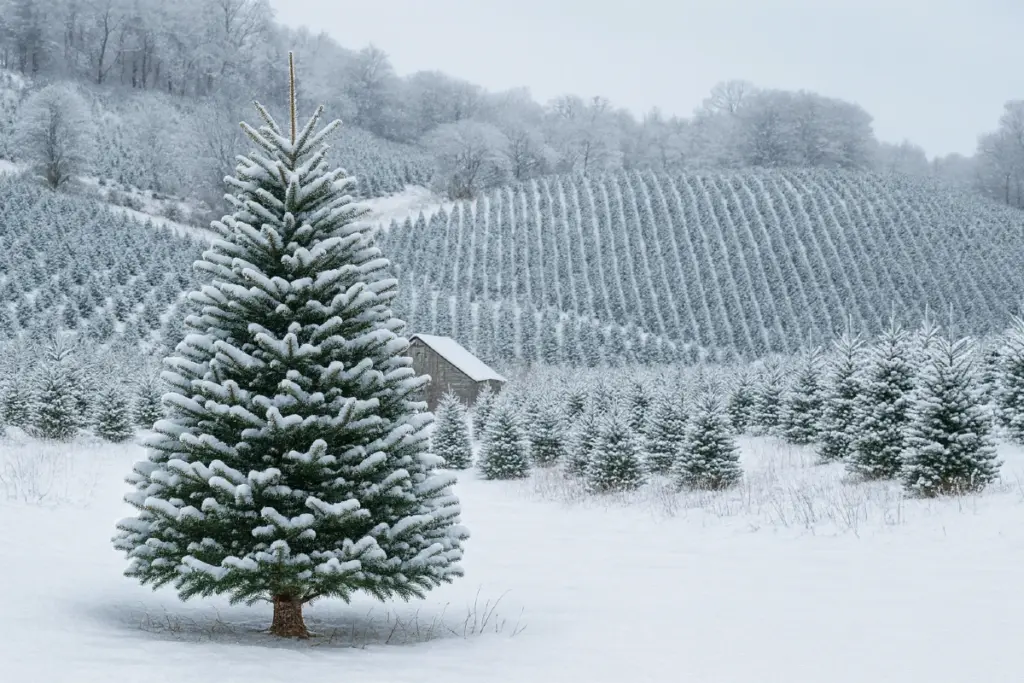
If there’s a Beyoncé of Christmas trees, this is it. Frasers dominate for a reason: strong branches that laugh at heavy ornaments, needles that cling tight for weeks, and a woodsy scent that screams Christmas. The dark green needles have a silver underside that sparkles under lights — instant holiday postcard. Downsides? They take years to grow, which means you’ll pay more. Worth it.
👉 Learn more about the Fraser Fir
Douglas Fir (The Classic Standby)
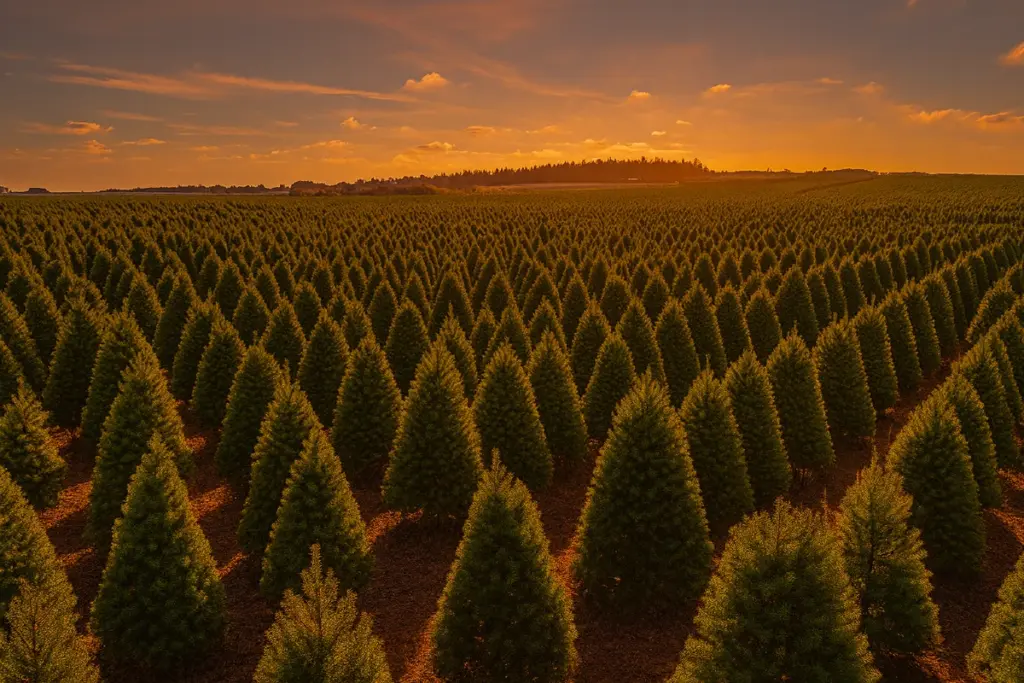
The Douglas is all about that full, bushy look. Its soft needles radiate around the branch, and when crushed, they give off a sweet, almost citrusy smell. It’s cheaper and easier to find than a Fraser, but here’s the catch: the branches aren’t as strong. If your ornament collection includes heirloom glass globes, think twice. Still, for sheer fullness and price, Douglas is a win.
👉 Learn more about the Douglas Fir
Noble Fir (The Heavyweight Champ)
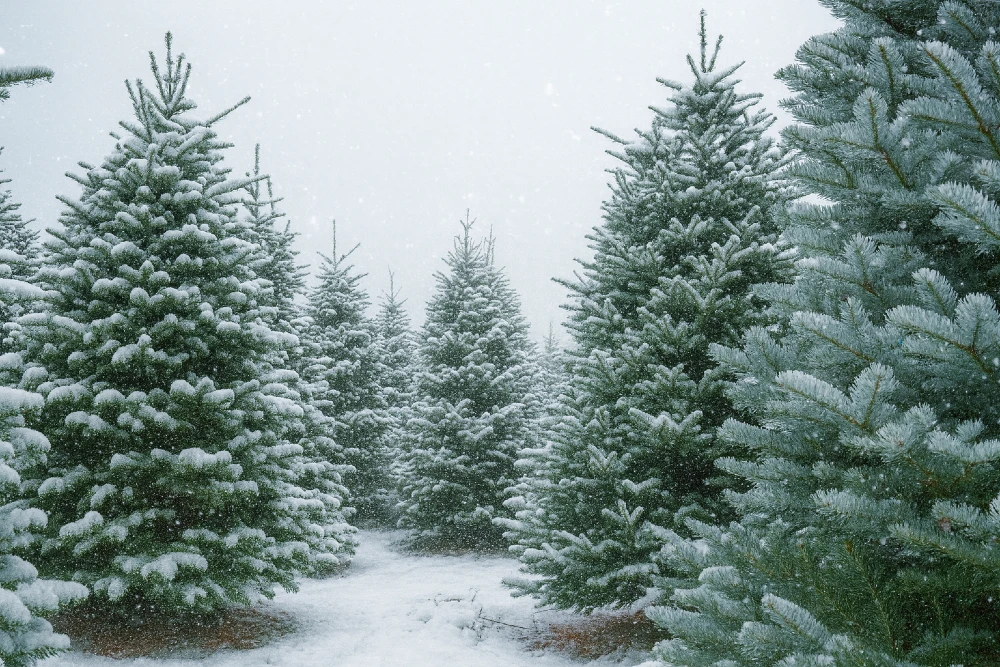
Want to hang the heaviest ornaments in the box? Go Noble. These trees come with stiff, layered branches that can hold anything — no sagging, no problem. Their needles are bluish-green, their shape is naturally symmetrical, and they last forever indoors. The fragrance is subtler than Balsam or Fraser, but the staying power makes up for it. Nobles grow slowly, mostly in the Pacific Northwest, which explains the premium price tag.
👉 Learn more about the Noble Fir
Balsam Fir (The Fragrance Bomb)
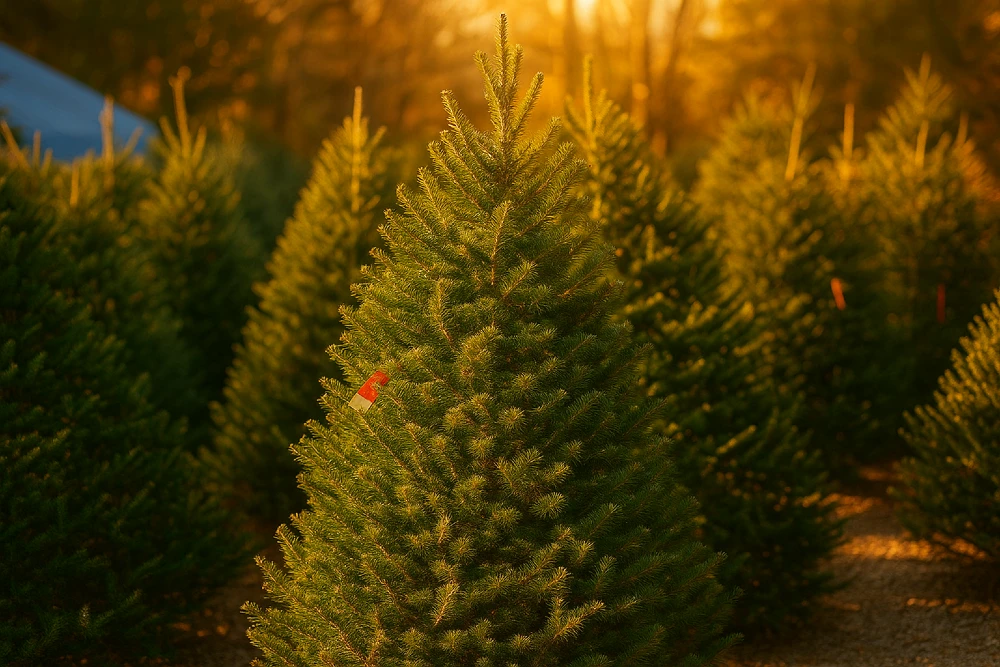
If scent is your top priority, this is the tree. Balsam fills your living room with that classic, spicy evergreen aroma the second you drag it inside. Its needles are soft, dark green, and cling reasonably well if you water daily. The shape is pyramidal and traditional — the kind of tree you picture in old Christmas cards. The trade-off? Balsam doesn’t last quite as long as a Fraser, so don’t buy it too early.
👉 Learn more about the Balsam Fir
Scotch Pine (The Needle Retention King)
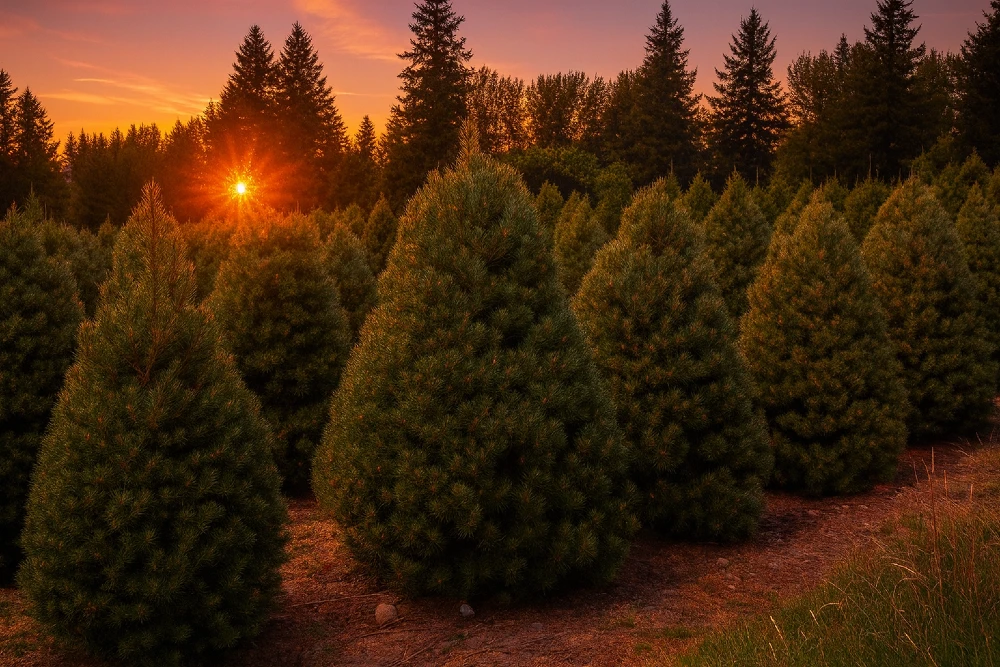
This tree is tough. Even if you forget to water it for a day (or three), its stiff, dark-green needles stay put. Farmers love growing it because it ships and holds up better than almost anything else. Shape-wise, Scotch Pines are dense and conical, though sometimes less elegant than firs. The fragrance is mild, not overwhelming. Budget-wise, it’s often one of the more affordable options — a solid family-friendly pick.
👉 Learn more about the Scotch Pine
Colorado Blue Spruce (The Show-Off)
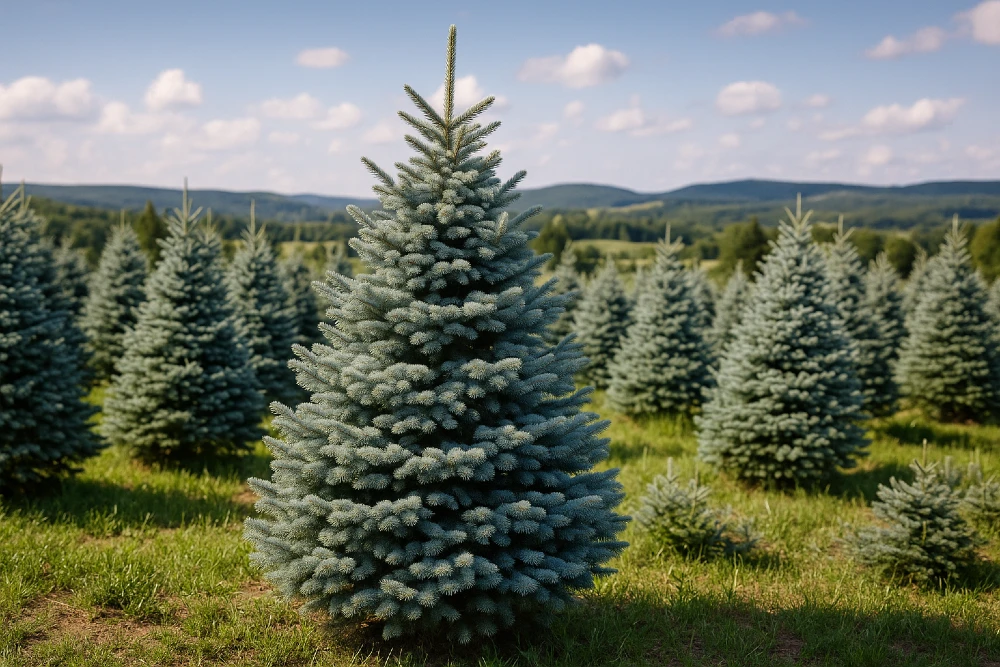
This tree is pure eye candy. With needles that shimmer blue-silver, it stands out like no other. Symmetrical, stiff, and dramatic — perfect for Instagram. But there’s a catch: the needles are sharp as needles get. Handle with gloves unless you like getting poked, and don’t expect the same needle retention you’d get from a fir. The fragrance is subtle, the look is unbeatable, but it’s more high-maintenance.
👉 Learn more about the Colorado Blue Spruce
Concolor Fir / White Pine (The Soft Touch)
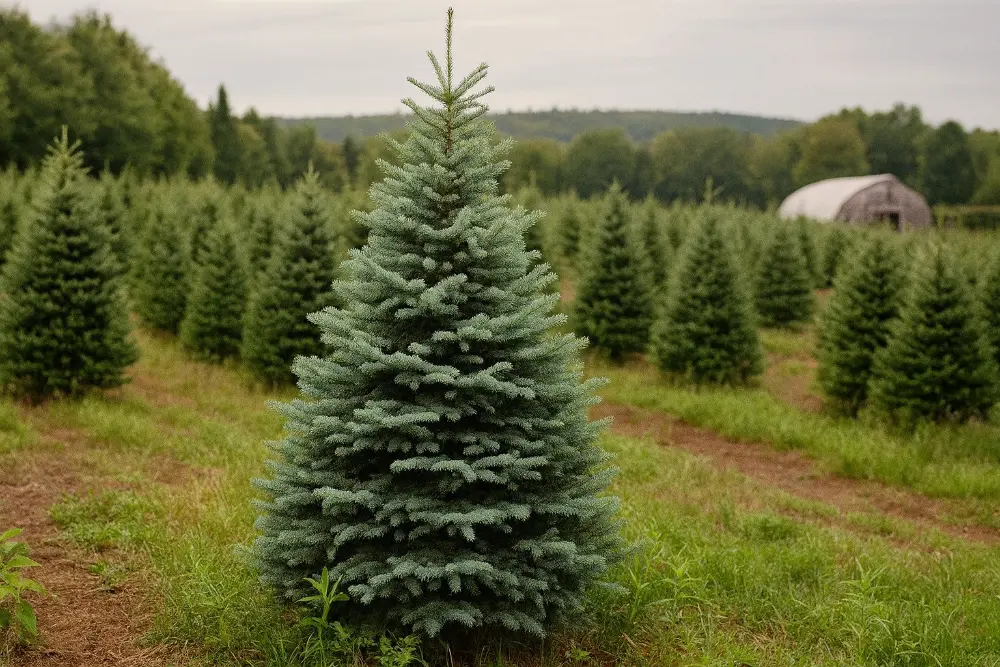
Looking for a tree that’s gentle on little hands and paws? Concolor Fir, often sold as White Pine, is your best bet. Its long, soft needles give it a fluffy, delicate look, and when crushed, they release a surprising citrusy scent — think orange peel meets pine forest. These trees don’t have the branch strength for heavy ornaments, but they’re perfect for families with young kids or anyone who loves a softer aesthetic. Prices are usually mid-range, and they’re increasingly popular for their unique vibe.
👉 Learn more about the Concolor Fir (White Pine)
Other Notable Varieties
They may not be the headliners, but these deserve a quick shoutout: Nordmann Fir (long-lasting, low fragrance), Canaan Fir (like a Fraser-Balsam hybrid), Grand Fir (citrusy scent, full look), Serbian Spruce (elegant and narrow), White Spruce (classic but weaker needle hold), Cook Blue Fir (rare but striking), Lodgepole Pine (rustic, regional), and Monterey Pine (popular abroad, limited here).
Comparison Tool: Which Christmas Tree Wins for You?
Not sure which tree fits your vibe? Here’s the quick-and-dirty breakdown of the seven big players.
| Tree | Needle Retention | Fragrance | Branch Strength | Shape & Look | Price Range | Best For |
|---|---|---|---|---|---|---|
| Fraser Fir | ⭐⭐⭐⭐⭐ (holds forever) | Strong, classic evergreen | Strong, upturned | Full, conical, silver-tipped | $$$ | Families, ornaments galore, the all-around champ |
| Douglas Fir | ⭐⭐⭐⭐ | Sweet, citrusy when crushed | Medium (not for heavy heirlooms) | Bushy, dense | $$ | Budget-conscious, love a full tree |
| Noble Fir | ⭐⭐⭐⭐⭐ | Subtle, fresh | Extra-strong (heavy ornaments welcome) | Layered, sculpted | $$$$ | Decorators, showpiece homes, ornament collectors |
| Balsam Fir | ⭐⭐⭐⭐ | Intense, spicy evergreen | Medium | Traditional pyramid shape | $$–$$$ | Scent-lovers, classic Christmas vibe |
| Scotch Pine | ⭐⭐⭐⭐⭐ (needles don’t drop) | Mild | Strong, stiff | Dense, uniform | $–$$ | Families, low-maintenance tree, budget win |
| Colorado Blue Spruce | ⭐⭐ | Subtle | Strong but sharp needles | Perfectly symmetrical, blue-silver color | $$–$$$ | Looks-first buyers, Instagram tree |
| Concolor Fir / White Pine | ⭐⭐⭐ | Light citrus, subtle | Weak (soft branches) | Fluffy, delicate, soft needles | $$ | Families with kids/pets, gentle décor |
Scale: ⭐ = weak → ⭐⭐⭐⭐⭐ = excellent
Where to Buy Your Christmas Tree
Here’s the truth: where you buy is almost as important as what you buy. The same Fraser Fir can feel like royalty on a farm and like roadkill in a grocery store lot. Here’s how each option stacks up.
Christmas Tree Farms (Cut-Your-Own)
- Pros: Freshness is unbeatable. You know exactly when that tree was cut (because you did it). Plus, it’s a full holiday experience — hayrides, cocoa, Instagram-worthy family pics.
- Cons: It’s a trip. If you live in the city, plan on a drive. Prices can be slightly higher than a lot, but you’re paying for freshness and fun.
Garden Centers & Nurseries
- Pros: Staff usually know their trees, and you’ll often find a wider selection of varieties than the local big-box. Trees are well cared for, not left to dry out.
- Cons: Prices are mid-to-high, and stock can move fast once December hits.
Big-Box Retailers & Grocery Stores
- Pros: Convenient. Grab a tree while you’re buying laundry detergent and snacks. Usually cheaper, too.
- Cons: These trees are pre-cut and shipped in bulk. Translation: they may have been cut weeks ago. Check freshness carefully or risk bringing home a crispy mess.
Pop-Up Lots
- Pros: They’re everywhere in December — easy access, lots of locations. Prices vary, and sometimes you get lucky with a good shipment.
- Cons: Quality is hit-or-miss. Some lots care for their trees, others treat them like firewood. You won’t always know which until you get it home.
Online Delivery
- Pros: Ultimate convenience. A fresh-cut tree shipped straight to your door. No hauling, no pine needles in the car.
- Cons: You don’t get to choose. If you’re picky about shape, symmetry, or fullness, rolling the dice online can be risky. Also, shipping adds cost
Getting Your Tree Home Safely
You picked the perfect tree. Don’t blow it on the ride home.
First rule: trunk forward, top back. That way the wind won’t strip your needles on the highway. Net it if possible — or at least wrap it in a tarp or blanket. Always strap it to roof rails, not through your windows like some DIY disaster. Use at least three tie-down points: base, middle, and top. No roof rack? Lay down a tarp inside the car and fold the seats — if the tree actually fits. And check your rearview mirror; if you can’t see out, you’re driving blind.
Bottom line: better to spend ten minutes strapping it down than spend Christmas Eve picking branches out of your upholstery.
Tree Care & Maintenance
Think of your tree like a houseguest: it needs water, the right spot, and a little attention to stay happy.
Day One: Make a fresh cut — about an inch off the bottom — before it goes in the stand. That opens up the wood so it can drink. Get it in water immediately.
Daily: A tree can chug up to a gallon the first day, then a quart a day after that. Never let the stand go dry — once the base seals, the tree stops drinking.
Placement: Keep it at least three feet from heat vents, fireplaces, or sunny windows. The cooler the room, the longer it lasts.
Additives? Skip the sugar, Sprite, aspirin, or bleach. Every myth has been tried. The verdict? Nothing beats plain water.
Do that, and a Fraser or Noble will last 4–6 weeks without shedding like crazy.
Safety Considerations
A Christmas tree is magic — until it turns into a torch.
- Fire Safety: Water it daily, keep it away from heat, and ditch it once it’s dry. Turn off lights before bed or when you leave the house.
- Electrical Safety: Use UL-listed lights, check for frayed wires, and don’t overload the outlet. Modern LEDs stay cooler and use less juice — win-win.
- Pets: Anchor the tree so cats can’t topple it, skip tinsel (it’s a vet’s nightmare), and block off the stand water. Pine sap + dog = upset stomach.
- Kids: Keep fragile ornaments higher up, watch the cords, and don’t block exits. Curious toddlers and glass ornaments never mix.
Bottom line: A little vigilance keeps your holiday centerpiece from turning into a holiday hazard.
Disposal & Recycling
When the needles are dropping and the water stand is bone dry, it’s time to say goodbye.
- Curbside Pickup: Most cities run tree recycling programs in early January. They’ll turn your old spruce into mulch. Just strip off lights, tinsel, and the stand first.
- Drop-Off Sites: Parks and transfer stations often take trees for free. Some even chip them on the spot.
- Composting or Mulching: Got a chipper? Break it down for mulch or cut branches for garden cover. Nature thanks you.
- Get Creative: Some communities use old trees for fish habitats or wildlife cover — but don’t toss yours in the nearest pond unless it’s part of an official program.
The faster you recycle, the less likely you’ll have a crispy fire hazard sitting in the corner.
Frequently Asked Questions
When’s the best time to buy?
First weekend of December is the sweet spot. Early enough to get the best trees, late enough that they’ll last through Christmas. Buy Thanksgiving weekend and you’ll pay more for trees that may dry out before the big day.
How long will my tree last?
With daily watering, a Fraser or Noble can cruise for 4–6 weeks. Balsam or Douglas usually give you 3–4. Forget to water and it’s game over in days.
Can I replant a living tree?
Yes, but only if you buy one balled-and-burlapped (roots attached). Keep it indoors for no more than 7–10 days, then plant it outside once the ground thaws. Cut trees? Forget it. They’re not coming back.
What if I have allergies?
Most “Christmas tree allergies” are actually mold and dust, not pine pollen. Hose the tree off before bringing it inside and run a HEPA filter nearby. If fragrance sets you off, choose a low-scent tree like Nordmann Fir or White Pine.
Real vs. artificial: which is better for the planet?
A real tree, recycled properly, usually beats plastic. Artificial trees only “win” if you keep them for a decade or more. Otherwise, real trees are renewable, compostable, and smell a whole lot better.
Conclusion: Pick Like a Pro
Here’s the deal: your Christmas tree is the centerpiece of the season. Don’t grab the first sad spruce you see in a parking lot. Check for freshness, know your species, and buy from a place that treats their trees with care.
Want long-lasting and strong? Go Fraser or Noble. Want fragrance that slaps you in the face? Balsam or Concolor. Want budget-friendly toughness? Scotch Pine’s your guy. Want pure Instagram drama? Blue Spruce all the way.
At the end of the day, the right tree isn’t just décor — it’s memory fuel. It’s where the kids open gifts, where the family photos happen, where Christmas morning actually feels like Christmas.